

| Social Wasps in Nottinghamshire | ||
| Social Wasp identification | ||
| .... | ||
| Wasps and other social
insects have always maintained a huge fascination for me
personally over the years but they still suffer from
extremely bad public opinion. Wasps are extremely
fascinating insects and usually attack only if provoked
or in a position where they feel threatened. Although some species naturally show a more aggressive tendancy, they are on the whole harmless. This page shows most of the social wasps including Vespa, Vespula and Dolichovespula sp, that occur in Nottinghamshire and provides photographs as an aid to their identification. Wasps nest in a variety of sites. Most choose sites which offer some degree of protection from the elements and predators. Roof spaces, hollow trees and holes in the ground are all commonly used. There are a few UK species which nest openly in trees, with the nest being suspended from the branches and quite exposed. |
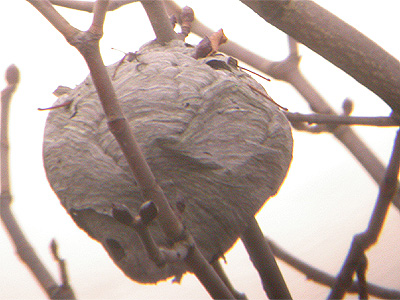 |
|
| .... | ||
| Known
species of social wasps in Nottinghamshire Nottinghamshire currently has at least seven species of social wasps (Vespa, Vespula and Dolichovespula sp) and probably eight. These are Hornet (Vespa crabro); Median Wasp (Dolichovespula media); Saxon Wasp (Dolichovespula saxonica); Tree Wasp (Dolichovespula sylvestris); Red Wasp (Vespula rufa); Common Wasp (Vespula vulgaris) and German Wasp (Vespula germanica). The probable species is Norwegian Wasp (Dolichovespula norwegica) but we cannot find any modern records of this wasp through the usual internet resources. It was listed in Carr's "The Invertebrate Fauna of Nottinghamshire" with nests at Lenton and Kirkby-in-Ashfield, both records dating to pre-1916, at the time of the books publication. Median Wasp and Saxon Wasp are relatively recent colonisers of the county. |
||
| .... | ||
|
The nest
shown in the above photograph, was taken in December 2005
at Worksop. It was suspended about 15 feet above ground
and was about the size of a small football. It is likely
that the species responsible for it's construction was
the Median Wasp Dolichovespula media. Species identification The only way to accurately determine species' identity, is to look at the head markings - paying particular attention to the amount and shape of the yellow and black markings on the forehead, together with yellow markings on the thorax. Abdominal markings vary within species' and cannot be used with any degree of success in acheiving an accurate ID. The four abdomens on the left show examples of Vespula vulgaris (top left) Vespula rufa (top right) Dolichovespula saxonica (bottom left) and Dolichovespula sylvestris (bottom right). |
||||||||||
| Hornet Vespa crabro (Linnaeus,
1758) |
||
| By any standards, the Hornet is one of our most impressive and imposing insects. Workers have a length of nearly 3.5cm, which means it is by far the largest species of wasp found in the UK. It is also quite uncommon, but has increased it's range during recent years following a succession of mild Winters. The south-east UK is still perhaps it's real stronghold, but it can now be encountered just about anywhere in Nottinghamshire, although the Dukeries and Sherwood Forest area is perhaps the most likely place to see it. Nests are usually found within dead or decaying trees. There are several sub-species of the Hornet found throughout Europe, with Vespa crabro vexator (Harris 1776) occurring only in the UK. Click here to read more about the Hornet at Eakring and it's status in Nottinghamshire. | ||
| .... | ||
| V. crabro worker photographed at Lound Wood on August 30th 2003 | V. crabro queen photographed at Sherwood Forest on May 22nd 2006 | |
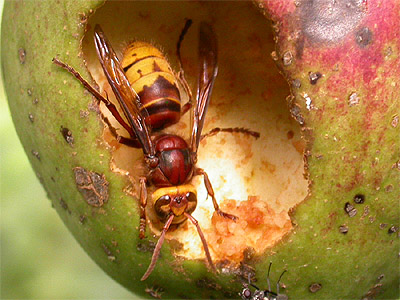 |
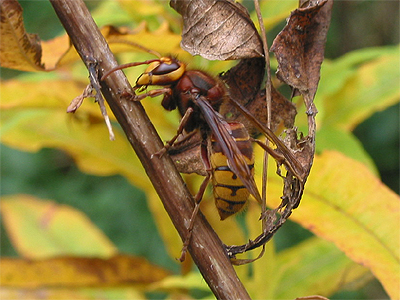 |
|
| Median
Wasp Dolichovespula media (Retzius,
1783) |
||
| This is a fairly recent UK colonist, first appearing in 1980 and quickly spreading northwards. It is a large species and at first glance distinguishable from most other wasps by the greater amount of black on the abdomen. Nests are typically found in hedgerows. The queen looks very much like a worker Hornet. Sometimes known as the French Wasp, Dolichovespula media is widespread and increasing it's range in Nottinghamshire. Certainly the woodlands in the north of the county hold numbers of this wasp. | ||
| .... | ||
| D. media queen photographed at Nottingham on April 17th 2006 | D. media queen photographed at Nottingham on April 17th 2006 | |
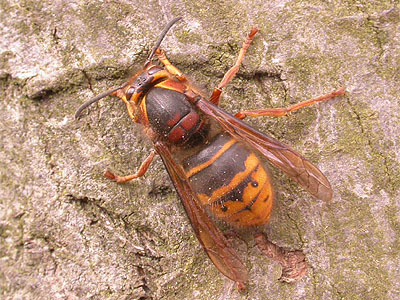 |
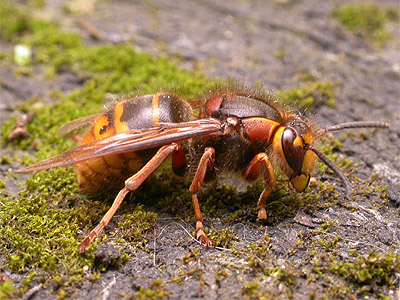 |
|
| .... | ||
| D. media worker showing head markings, photographed at Sherwood Forest on July 25th 2006 | D. media worker showing thoracic and abdominal markings, photographed at Eakring village on July 23rd 2006 | |
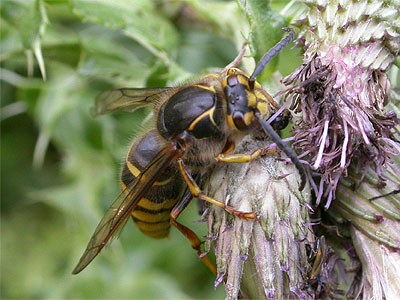 |
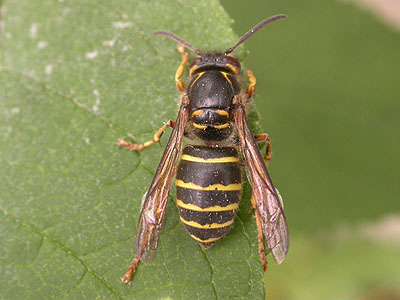 |
|
| Saxon
Wasp Dolichovespula saxonica
(Fabricius, 1793) |
||
| A large wasp, but not commonly recorded. This was our first record of Saxon Wasp, when it landed on our car when parked at woodland near Worksop. This is a scarce wasp in the UK, with most records coming from south-eastern areas. | ||
| .... | ||
| D. saxonica worker showing thoracic markings, photographed near Worksop, August 2010 | D. saxonica worker showing facial markings, photographed near Worksop, August 2010 | |
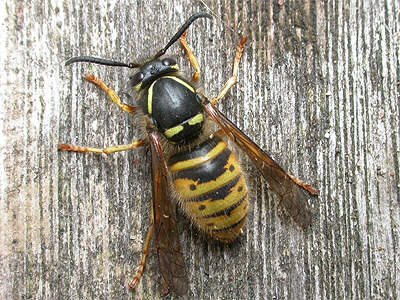 |
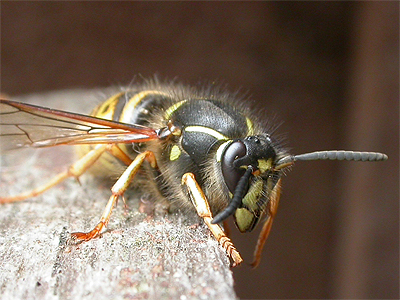 |
|
| Tree
Wasp Dolichovespula
sylvestris (Scopoli, 1763) |
||
| The key to this Wasp's identification is the elongated face, which in Common Wasp is more rounded. This is a fairly common wasp in the southern counties of the UK and in Scotland. There are fewer records across the rest of the UK. | ||
| .... | ||
| D. sylvestris male showing head markings, photographed at Lound Wood August 5th 2005 | D. sylvestris male showing thoracic and abdominal markings, photographed at Lound Wood August 5th 2005 | |
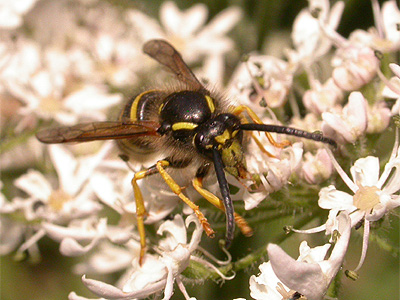 |
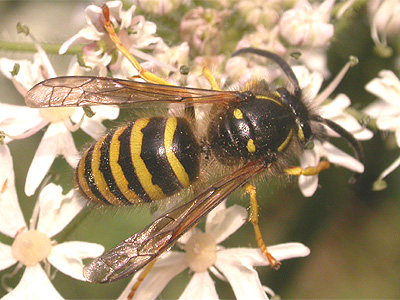 |
|
| Common
Wasp Vespula vulgaris (Linnaeus,
1758) |
||
| The Common Wasp is by far the most regularly encountered species, usually nesting below ground in old rodent holes, but frequently found in roofspaces and lofts etc. Colonies can build up during long Summers, to eventually total several thousand by the time the colony dies at the onset of cold weather. | ||
| .... | ||
| V.vulgaris queen photographed at Forest Town, Mansfield on May 29th 2006 | V.vulgaris queen photographed at Forest Town, Mansfield on May 29th 2006 | |
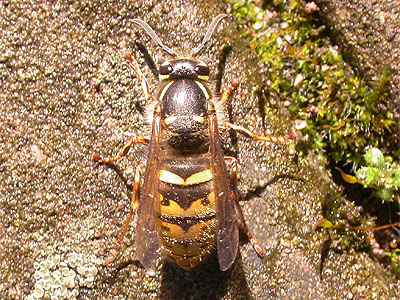 |
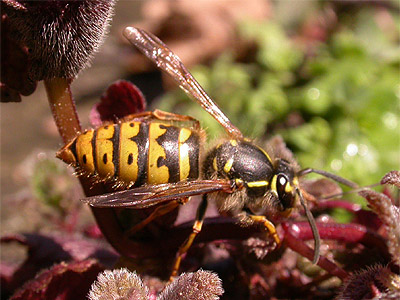 |
|
| German
Wasp Vespula germanica (Fabricius,
1793) |
||
| The German Wasp can be recognised by the three small black dots just above the mouth and by the black diamond and triangle markings on the abdominal segments. It seems to be a fairly common species at Eakring and throughout Nottinghamshire, with only V. vulgaris being more abundant. | ||
| .... | ||
| V. germanica queen photographed at Church Hill, Eakring on April 29th 2006 | V. germanica queen photographed at Church Hill, Eakring on April 29th 2006 | |
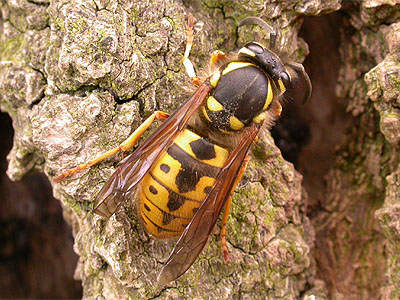 |
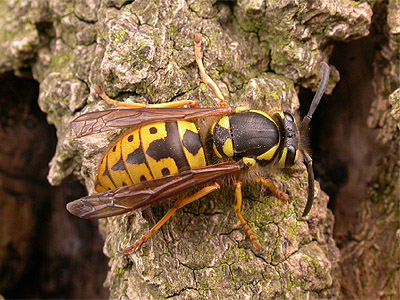 |
|
| .... | ||
| V. germanica worker showing head markings, photographed at Eakring Flash August 25th 2005 | V. germanica worker showing thoracic and abdominal markings, photographed at Eakring Flash August 25th 2005 | |
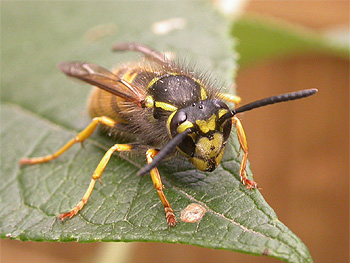 |
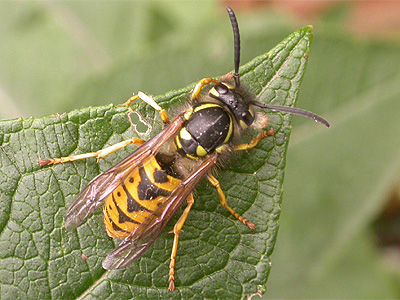 |
|
| Red
Wasp Vespula rufa (Linnaeus,
1758) |
||
| A ground-nesting species which appears through my own casual observations over the years, to be commonest in the Sherwood Forest area of Nottinghamshire. Budby Soouth Forest is a regular site and others have been found recently at Bevercotes Pit Wood and Eakring. It is quite an easy species to identify, with the rufous markings on the first and second abdominal segments (coupled with the pattern of black markings) usually being diagnostic. The extent of red colouration can vary. | ||
| .... | ||
| V. rufa worker showing abdominal markings, photographed at Bevercotes Pit Wood on July 18th 2006 | V. rufa worker showing head and thoracic markings, photographed at Lound Wood, Eakring on July 1st 2007 | |
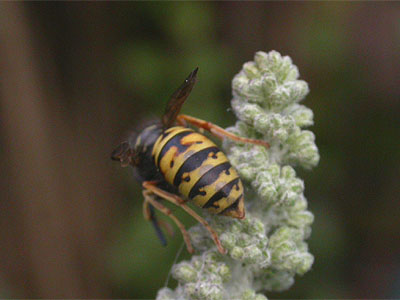 |
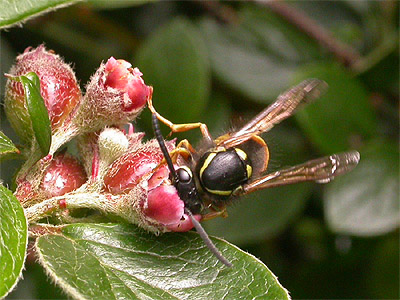 |
|
| .... | ||
| V. rufa worker showing side view of abdominal markings, photographed at Parliament Oak on August 18th 2006 | V. rufa male showing thoracic and abdominal markings, plus the typical long antennae associated with males, photographed at Eakring Flash on August 14th 2006 | |
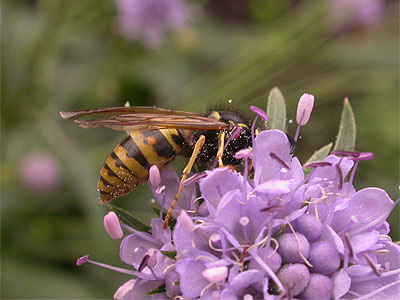 |
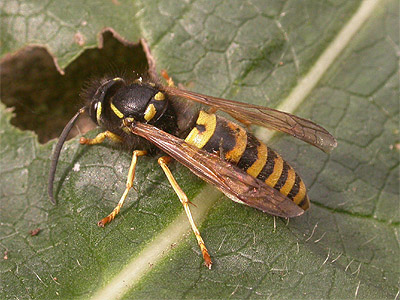 |
|